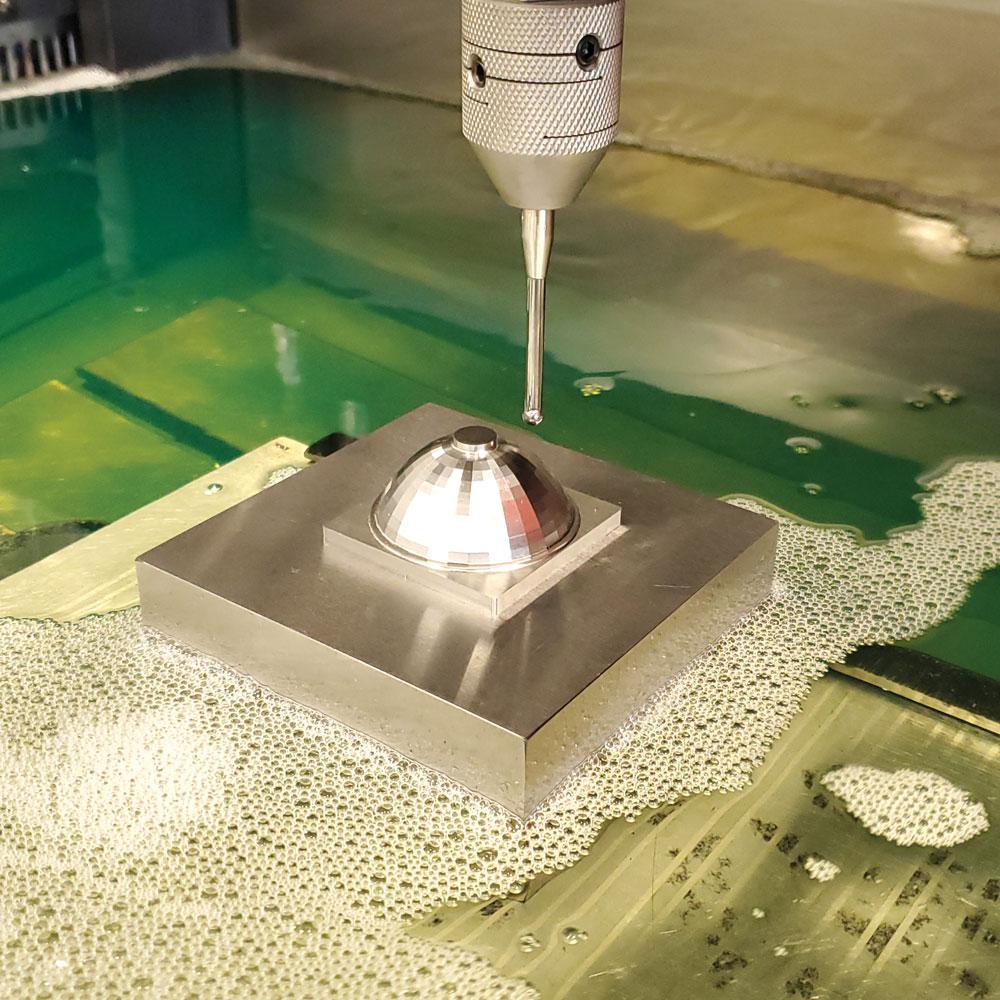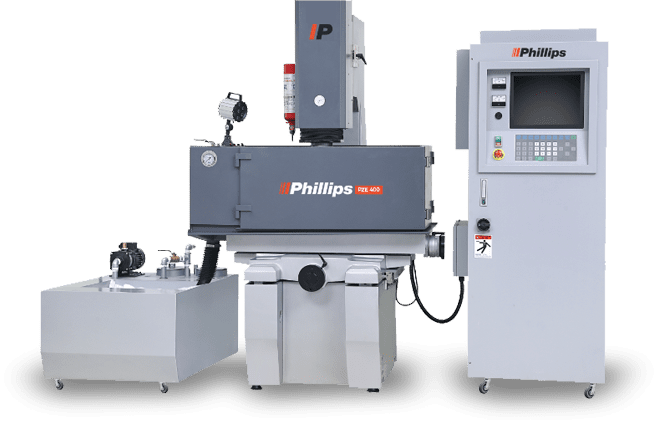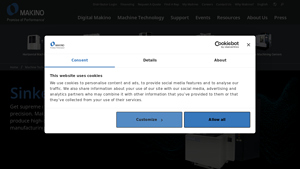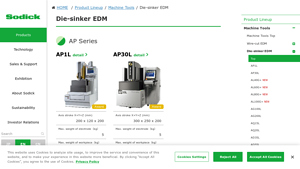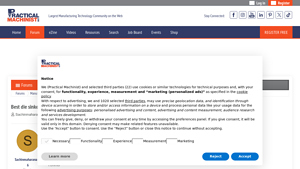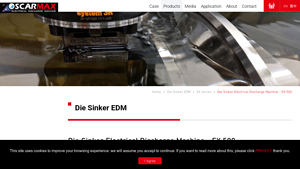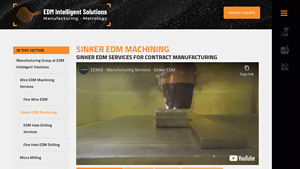Die Sinking Edm Machine Guide: Type, Cost, Top List…
Introduction: Navigating the Global Market for die sinking edm machine
In the dynamic landscape of global manufacturing, sourcing a die sinking EDM machine that meets specific operational needs can pose significant challenges for international B2B buyers. With the increasing demand for precision in industries ranging from aerospace to automotive, understanding the nuances of die sinking EDM technology is crucial for making informed purchasing decisions. This guide offers a comprehensive exploration of die sinking EDM machines, covering various types, their applications, key features, and supplier vetting processes, along with cost considerations.
Navigating the complexities of this market can be daunting, especially for buyers from Africa, South America, the Middle East, and Europe, including emerging economies like Vietnam and Brazil. This resource equips decision-makers with the insights necessary to evaluate the best options for their unique manufacturing requirements. By detailing the latest advancements in technology, such as intelligent power generators and automated systems, we aim to empower buyers to optimize their investments in precision machining.
Through a careful examination of the competitive landscape, this guide not only highlights reputable suppliers but also offers practical advice on negotiating terms and ensuring quality. As you embark on the journey of selecting the right die sinking EDM machine, this guide serves as your trusted partner in making strategic, informed choices that drive productivity and innovation in your operations.
Understanding die sinking edm machine Types and Variations
| Type Name | Key Distinguishing Features | Primary B2B Applications | Brief Pros & Cons for Buyers |
|---|---|---|---|
| Compact EDM | Smaller footprint, designed for reliability and cost-effectiveness | Electronics, small molds | Pros: Space-saving, economical. Cons: Limited capacity and travel range. |
| Modular EDM | Versatile design with customizable configurations | Aerospace, automotive, large molds | Pros: High flexibility, tailored solutions. Cons: Potentially higher initial investment. |
| Double Head EDM | Two heads for simultaneous operations, increasing productivity | High-volume production, complex geometries | Pros: Significant time savings, higher throughput. Cons: More complex setup and maintenance. |
| High-Power EDM | Advanced digital generators for enhanced power and efficiency | Aerospace, medical devices | Pros: Superior performance, better surface finishes. Cons: Higher operational costs. |
| Micro EDM | Specialized for ultra-precision applications | Medical devices, micro-components | Pros: Exceptional detail, ideal for intricate designs. Cons: Requires skilled operators, more expensive. |
What Are the Characteristics of Compact EDM Machines?
Compact EDM machines are designed with a smaller footprint, making them ideal for facilities with limited space. These machines typically feature a reliable design that balances cost and performance. They are particularly suited for industries requiring precision in smaller molds and electronic components. When considering a compact EDM, buyers should evaluate their production volume needs, as these machines may have limitations in capacity and travel range compared to larger models.
How Do Modular EDM Machines Offer Flexibility?
Modular EDM machines are characterized by their versatile design, allowing manufacturers to customize configurations based on specific production requirements. With options for various travel sizes and features, these machines are perfect for industries like aerospace and automotive that require complex mold shapes. Buyers should assess their long-term needs and the potential for future upgrades, as modular systems can adapt to changing production demands but may require a higher initial investment.
What Advantages Do Double Head EDM Machines Provide?
Double head EDM machines enhance productivity by allowing simultaneous operations, which is particularly beneficial for high-volume production environments. These machines can significantly reduce erosion times and increase efficiency, making them ideal for complex geometries and large molds. Buyers should consider the complexity of setup and maintenance, as the advanced features of double head machines may require more technical expertise and training.
Why Choose High-Power EDM Machines?
High-power EDM machines utilize advanced digital generators that provide enhanced power and efficiency, making them suitable for demanding applications in aerospace and medical device manufacturing. These machines deliver superior performance and high-quality surface finishes, although they often come with higher operational costs. When purchasing high-power EDM machines, buyers should analyze the potential return on investment through improved production quality and speed.
What Makes Micro EDM Machines Unique?
Micro EDM machines are specialized for ultra-precision applications, allowing for the creation of intricate designs and components, especially in the medical and electronics sectors. These machines require skilled operators to achieve the desired precision, which can lead to higher operational costs. Buyers interested in micro EDM should evaluate their specific application needs and ensure they have access to the necessary expertise for optimal machine operation.
Key Industrial Applications of die sinking edm machine
| Industry/Sector | Specific Application of die sinking edm machine | Value/Benefit for the Business | Key Sourcing Considerations for this Application |
|---|---|---|---|
| Aerospace | Manufacturing of intricate turbine components | High precision and reliability in safety-critical components | Ensure compliance with aerospace standards and certifications. |
| Automotive | Creation of molds for complex automotive parts | Reduces production time and enhances part accuracy | Look for machines with advanced automation features. |
| Electronics | Production of precision connectors and circuit components | Achieves tight tolerances essential for electronic performance | Consider machines capable of handling small, intricate designs. |
| Medical Devices | Fabrication of custom implants and surgical tools | Ensures high biocompatibility and precision in medical applications | Source machines with capabilities for hard-to-machine materials. |
| Energy Sector | Machining of components for turbines and generators | Increases efficiency and durability of energy production equipment | Assess energy consumption and operational costs of machines. |
How is Die Sinking EDM Used in Aerospace Manufacturing?
In the aerospace industry, die sinking EDM machines are crucial for producing intricate turbine components that require high precision and reliability. These components are often subjected to extreme conditions, making their accuracy vital for safety. The ability to create complex geometries in hard materials like titanium and nickel alloys is a significant advantage. For international buyers, it’s essential to source machines that comply with stringent aerospace standards and certifications, ensuring the quality and reliability of manufactured parts.
What Role Does Die Sinking EDM Play in Automotive Mold Creation?
In the automotive sector, die sinking EDM is extensively used to create molds for complex automotive parts, such as engine components and body panels. This technology allows manufacturers to achieve tight tolerances and intricate designs that traditional machining methods may struggle to produce. The reduction in production time and enhanced accuracy directly translates to cost savings and improved product quality. Buyers should prioritize sourcing machines equipped with advanced automation features to further streamline their production processes.
How Does Die Sinking EDM Benefit the Electronics Industry?
The electronics industry relies heavily on die sinking EDM machines for the production of precision connectors and circuit components. The ability to achieve tight tolerances is essential for the functionality and performance of electronic devices. Die sinking EDM can create intricate designs that are often impossible with conventional machining. When sourcing equipment, buyers should look for machines capable of handling small, intricate designs while ensuring a high-quality surface finish to meet the demanding standards of the electronics sector.
Why is Die Sinking EDM Important for Medical Device Fabrication?
In the medical device sector, die sinking EDM is employed to fabricate custom implants and surgical tools, which require exceptional precision and biocompatibility. The ability to machine hard materials with intricate designs is critical for ensuring the performance and safety of medical applications. Buyers in this field should focus on sourcing machines that can handle hard-to-machine materials while ensuring compliance with medical device regulations to maintain product integrity and safety.
How Does Die Sinking EDM Enhance Efficiency in the Energy Sector?
The energy sector utilizes die sinking EDM for machining components used in turbines and generators, which are essential for efficient energy production. This process allows for the creation of complex shapes and features that enhance the durability and performance of energy equipment. International buyers should assess the energy consumption and operational costs of machines to ensure they align with sustainability goals while maximizing productivity and efficiency in their operations.
3 Common User Pain Points for ‘die sinking edm machine’ & Their Solutions
Scenario 1: Difficulty Achieving High Precision in Complex Designs
The Problem: Many B2B buyers in industries like aerospace and automotive struggle with achieving the required precision for complex designs when using conventional machining methods. The challenge is exacerbated when working with hard materials like superalloys or hardened steel. These materials often require intricate cavities and shapes that can be nearly impossible to create without the right technology. As a result, manufacturers may face increased production times, higher costs due to rework, and potential delays in meeting customer deadlines.
The Solution: To overcome this precision challenge, buyers should invest in high-quality die-sinking EDM machines that utilize advanced technology like Intelligent Power Generators (IPG) and algorithmic intelligence. When sourcing a machine, look for features such as customizable electrode shapes and dielectric fluid management to enhance machining accuracy. Additionally, consider opting for machines with programming software that simplifies the setup process, allowing for more complex designs to be produced efficiently. Regular training for operators on the latest EDM technologies can also greatly improve precision and reduce errors during the machining process.
Scenario 2: Long Production Times and Inefficiencies
The Problem: B2B manufacturers often find themselves dealing with long production cycles when machining components with die-sinking EDM. This inefficiency can lead to increased operational costs and reduced competitiveness in the market. Factors contributing to these delays include outdated machinery, lack of automation, and inadequate process controls that fail to optimize the erosion process.
The Solution: Investing in modern die-sinking EDM machines equipped with features such as dual-head capabilities can significantly reduce production times by up to 50%. When selecting a machine, buyers should prioritize those that offer modular designs, allowing for quick adjustments and the ability to handle multiple projects simultaneously. Incorporating automation features such as real-time monitoring and process optimization algorithms can also streamline operations. By ensuring that the machine is properly calibrated and that operators are trained in using the latest software tools, manufacturers can enhance efficiency and drastically cut down on production times.
Scenario 3: High Tool Wear and Maintenance Costs
The Problem: High tool wear is a common pain point for manufacturers using die-sinking EDM machines, especially when machining hard materials. Excessive tool wear not only leads to increased costs for replacements but also affects the quality of the finished product. This problem can be particularly pronounced in high-volume production settings where consistent quality is paramount.
The Solution: To mitigate tool wear, manufacturers should select die-sinking EDM machines that feature advanced spark control technologies, such as iGap, which regulate where sparks are generated during the machining process. This not only minimizes tool wear but also enhances the overall surface finish of the components. Additionally, buyers should implement a regular maintenance schedule to ensure that machines are operating at peak efficiency. Investing in quality tool materials, such as high-grade graphite or copper electrodes, can further reduce wear and extend tool life. Furthermore, training operators to monitor tool conditions and make adjustments as needed can help maintain optimal performance and reduce long-term costs associated with tool wear.
Strategic Material Selection Guide for die sinking edm machine
What Are the Common Materials Used in Die Sinking EDM Machines?
When selecting materials for die sinking EDM machines, several factors come into play, including the material’s properties, cost, and suitability for specific applications. Below, we analyze four common materials used in this process, focusing on their key properties, advantages and disadvantages, and considerations for international B2B buyers.
1. Graphite
Key Properties:
Graphite is known for its excellent electrical conductivity, thermal stability, and resistance to thermal shock. It can withstand high temperatures without deforming, making it suitable for die sinking applications.
Pros & Cons:
Graphite offers high durability and is relatively easy to machine into complex shapes. However, it can be more expensive than other materials and is prone to chipping during machining, which may affect the final product’s quality.
Impact on Application:
Graphite is particularly effective in creating intricate cavities and shapes, making it ideal for applications in aerospace and automotive industries.
Considerations for International Buyers:
Buyers should ensure compliance with international standards such as ASTM and JIS. Graphite’s availability may vary by region, affecting lead times and costs.
2. Copper
Key Properties:
Copper boasts excellent electrical conductivity and thermal properties, allowing for efficient energy transfer during the EDM process. It also has good corrosion resistance.
Pros & Cons:
Copper electrodes can produce superior surface finishes, making them ideal for high-precision applications. However, they are more expensive than graphite and can wear out faster, leading to higher replacement costs.
Impact on Application:
Copper is often used in applications requiring high precision, such as medical devices and electronic components, where surface finish is critical.
Considerations for International Buyers:
International buyers should consider the availability of copper and its compliance with local standards. Import tariffs and regulations may also affect costs.
3. Steel Alloys
Key Properties:
Steel alloys, particularly those with high carbon content, offer excellent strength and durability. They can withstand high pressures and temperatures, making them suitable for heavy-duty applications.
Pros & Cons:
While steel alloys are generally less expensive than graphite and copper, they can be more challenging to machine and may require specialized tools. Their durability makes them suitable for long-term applications, but they may not provide the same level of precision as other materials.
Impact on Application:
Steel alloys are commonly used in the manufacturing of molds and dies for various industries, including automotive and aerospace.
Considerations for International Buyers:
Buyers should be aware of the specific grades of steel alloys that comply with international standards such as ASTM and DIN. Regional availability may influence the choice of alloy.
4. Carbide
Key Properties:
Carbide is known for its hardness and wear resistance, making it suitable for high-performance applications. It can withstand extreme temperatures and pressures.
Pros & Cons:
Carbide offers exceptional durability and is ideal for producing complex shapes. However, it is more expensive than other materials and can be difficult to machine, requiring specialized equipment.
Impact on Application:
Carbide is often used in high-stress applications, such as in the aerospace industry, where durability and precision are paramount.
Considerations for International Buyers:
International buyers should consider the certification of carbide materials to ensure compliance with industry standards. The higher cost may also necessitate a thorough cost-benefit analysis.
Summary Table of Material Selection for Die Sinking EDM Machines
| Material | Typical Use Case for die sinking edm machine | Key Advantage | Key Disadvantage/Limitation | Relative Cost (Low/Med/High) |
|---|---|---|---|---|
| Graphite | Aerospace and automotive molds | High durability and easy to machine | Prone to chipping, higher cost | Medium |
| Copper | Medical devices and electronic components | Excellent surface finish and conductivity | Higher wear rate, expensive | High |
| Steel Alloys | Heavy-duty molds for automotive industry | Cost-effective and durable | Challenging to machine, less precision | Low |
| Carbide | Aerospace high-stress applications | Exceptional hardness and wear resistance | Expensive and difficult to machine | High |
This strategic material selection guide provides valuable insights for B2B buyers in selecting the right materials for die sinking EDM machines, ensuring they meet their specific application needs while considering cost and availability.
In-depth Look: Manufacturing Processes and Quality Assurance for die sinking edm machine
What are the Main Stages in the Manufacturing Process of Die Sinking EDM Machines?
The manufacturing process of die sinking EDM machines involves several critical stages, each designed to ensure high precision and quality. The primary stages include material preparation, forming, assembly, and finishing.
-
Material Preparation: This initial stage focuses on selecting high-quality materials, typically conductive metals like steel, copper, or graphite. These materials must meet specific standards to ensure they can withstand the electrical discharge process. The preparation often includes cutting and machining materials to the required dimensions, ensuring they are free from defects that could affect the final product’s performance.
-
Forming: During this stage, the shaped electrode is crafted, which plays a pivotal role in the EDM process. The electrode is designed to create a negative impression in the workpiece. Advanced machining techniques, such as CNC milling, are often employed to achieve the intricate shapes required. The forming process also involves ensuring that the electrode’s geometry is precise, as even minor deviations can lead to inefficiencies and inaccuracies in the final product.
-
Assembly: Once the components are formed, they are meticulously assembled. This stage involves integrating the electrode, workpiece holder, and dielectric fluid system. Precision is crucial here, as any misalignment can impact the machine’s performance. Automated assembly techniques may be employed to enhance accuracy and reduce human error.
-
Finishing: The final stage involves rigorous finishing processes to enhance the machine’s performance and aesthetics. This can include surface treatments, coatings, and final inspections. The finishing process is vital for ensuring that the machine meets the required specifications and operates efficiently under various conditions.
What Key Techniques are Used in Manufacturing Die Sinking EDM Machines?
Several advanced techniques are employed during the manufacturing of die sinking EDM machines to ensure they operate at optimal levels:
-
Electrical Discharge Machining (EDM): This is the core technique that utilizes electrical discharges to remove material. The precision of this process allows for the creation of complex geometries that would be challenging to achieve with traditional machining methods.
-
Computer Numerical Control (CNC): CNC technology is integral to both the forming and assembly stages. It ensures that components are machined with high precision and that they conform to the specified tolerances.
-
Quality Control Software: Many manufacturers integrate advanced software solutions for quality control throughout the manufacturing process. These tools help track production metrics and ensure compliance with quality standards.
-
Automated Testing: The use of automated testing equipment allows for real-time monitoring of machine performance during manufacturing, ensuring that any deviations from quality standards are promptly addressed.
How is Quality Assurance Implemented in Die Sinking EDM Machine Manufacturing?
Quality assurance is a cornerstone of the manufacturing process for die sinking EDM machines. It involves several international standards and industry-specific regulations to ensure products meet stringent quality requirements.
-
Relevant International Standards: Many manufacturers adhere to ISO 9001, which outlines the criteria for a quality management system. Compliance with this standard demonstrates a commitment to quality and continuous improvement. Additionally, industry-specific certifications such as CE marking for European markets and API standards for oil and gas applications are often pursued.
-
Quality Control Checkpoints: The quality control process typically includes several checkpoints:
– Incoming Quality Control (IQC): This step involves inspecting raw materials and components before they enter the production line. This ensures that only materials meeting quality standards are used.
– In-Process Quality Control (IPQC): During the manufacturing process, regular checks are conducted to monitor quality and performance. This may involve measuring tolerances and verifying that manufacturing processes adhere to specified parameters.
– Final Quality Control (FQC): Once the machine is assembled, a final inspection is performed to ensure it meets all operational and safety standards. This may include functional tests and performance evaluations. -
Common Testing Methods: Various testing methods are employed to verify quality, including:
– Dimensional Inspection: Using tools like calipers and micrometers to ensure parts meet specified dimensions.
– Functional Testing: Verifying that the machine operates correctly under normal and extreme conditions.
– Electrical Testing: Ensuring that electrical components function as intended, including testing for short circuits and insulation resistance.
How Can B2B Buyers Verify Supplier Quality Control?
B2B buyers looking to invest in die sinking EDM machines should take proactive steps to verify the quality control measures employed by suppliers. Here are some actionable strategies:
-
Conduct Audits: Regular audits of potential suppliers can provide insights into their manufacturing processes, quality control systems, and adherence to international standards. Buyers should request access to audit reports and certifications to evaluate compliance.
-
Request Quality Reports: Suppliers should be able to provide documentation of their quality control processes, including IQC, IPQC, and FQC reports. These documents can reveal the thoroughness of their quality assurance practices.
-
Engage Third-Party Inspectors: Utilizing third-party inspection services can add an additional layer of assurance. These independent entities can conduct their evaluations and verify that products meet specified standards before shipment.
What Are the Quality Control and Certification Nuances for International B2B Buyers?
When sourcing die sinking EDM machines from international suppliers, particularly in regions like Africa, South America, the Middle East, and Europe, buyers should be aware of several nuances:
-
Certification Recognition: Different regions may have varying standards and certifications. Buyers should ensure that the supplier’s certifications are recognized in their respective markets. For instance, CE marking is crucial for selling machines in Europe, while UL certification may be necessary for North American markets.
-
Cultural and Regional Differences: Understanding cultural attitudes towards quality can impact supplier relationships. Buyers may need to invest time in educating suppliers about their quality expectations and standards.
-
Logistics and Compliance: Importing machinery often involves navigating complex regulations and customs requirements. Buyers should ensure that suppliers are compliant with local regulations in their respective countries to avoid delays or penalties.
By understanding these manufacturing processes and quality assurance practices, B2B buyers can make informed decisions when sourcing die sinking EDM machines, ensuring they invest in high-quality, reliable equipment that meets their operational needs.
Practical Sourcing Guide: A Step-by-Step Checklist for ‘die sinking edm machine’
Introduction
This sourcing guide provides a practical checklist for B2B buyers seeking to procure die-sinking EDM machines. By following these steps, buyers can ensure they make informed decisions that align with their operational needs and maximize their investment.
Step 1: Define Your Technical Specifications
Before initiating the procurement process, it’s essential to clearly outline your technical requirements. Consider factors such as the size of the workpieces, the materials you’ll be machining, and the complexity of the shapes needed. This step ensures that you select a machine capable of meeting your specific production demands.
- Key specifications to consider:
- X, Y, and Z travel dimensions.
- Maximum electrode size and weight.
- Power supply and generator capabilities.
Step 2: Research Available Technologies
Understanding the various technologies available in die-sinking EDM machines can significantly influence your decision. Different manufacturers may offer unique features such as advanced power generators, automation capabilities, and energy efficiency.
- Focus on:
- Intelligent Power Generators that enhance precision.
- Software solutions for programming and optimizing machining processes.
- Innovations like dual-head machines for increased productivity.
Step 3: Evaluate Potential Suppliers
Before committing to a purchase, thoroughly vet potential suppliers. Request detailed company profiles, case studies, and references from buyers in similar industries or regions. This research will provide insight into the supplier’s reliability and the performance of their machines.
- Consider:
- The supplier’s years of experience in the EDM market.
- Customer testimonials and success stories.
- Support services offered, such as training and maintenance.
Step 4: Verify Supplier Certifications and Compliance
Ensure that the suppliers you are considering comply with international standards and possess relevant certifications. This verification is crucial for ensuring the quality and safety of the machines you are purchasing.
- Look for:
- ISO certifications related to manufacturing and quality control.
- Compliance with environmental regulations, especially if operating in regions with strict laws.
Step 5: Request Demonstrations and Trial Runs
Whenever possible, request a demonstration of the machine or a trial run before finalizing your purchase. This hands-on experience allows you to assess the machine’s performance and ease of use.
- Key considerations during demonstrations:
- Ease of operation and programming.
- Quality of the finished parts.
- Machine stability and noise levels during operation.
Step 6: Assess Total Cost of Ownership
When evaluating options, consider the total cost of ownership (TCO) rather than just the initial purchase price. TCO includes maintenance, energy consumption, and any additional software or tooling required.
- Break down costs into:
- Initial acquisition costs.
- Expected maintenance and operational costs over time.
- Potential savings from energy-efficient technologies.
Step 7: Negotiate Terms and Conditions
Once you have selected a supplier, engage in negotiations to finalize the terms and conditions of the purchase. This step is critical to ensure you receive the best deal and understand the warranty, support, and service agreements.
- Key points to negotiate:
- Warranty duration and coverage.
- Availability of spare parts and service response times.
- Training and support for your operational team.
By following this checklist, international B2B buyers can approach the procurement of die-sinking EDM machines with confidence, ensuring they make decisions that align with their technical and operational needs.
Comprehensive Cost and Pricing Analysis for die sinking edm machine Sourcing
What Are the Key Cost Components of Die Sinking EDM Machines?
When considering the sourcing of die sinking EDM machines, understanding the cost structure is crucial for international B2B buyers. The primary cost components include:
-
Materials: The quality of materials used in the production of die sinking EDM machines significantly impacts the overall cost. High-grade conductive materials such as copper and graphite for electrodes, as well as robust structural materials for the machine frame, contribute to higher costs but enhance durability and performance.
-
Labor: Skilled labor is essential for the manufacturing and assembly of EDM machines. Labor costs can vary significantly based on the region, skill levels required, and local wage standards. Countries with advanced manufacturing sectors may have higher labor costs, which could affect the final pricing.
-
Manufacturing Overhead: This includes costs related to factory operations, utilities, maintenance, and equipment depreciation. Efficient manufacturing processes can help minimize these overheads, influencing the machine’s final price.
-
Tooling: Tooling costs involve the creation of custom molds and fixtures required for machine production. These costs can be substantial, particularly for machines with complex specifications, impacting the total investment for buyers.
-
Quality Control (QC): Ensuring high precision and quality finishes in die sinking EDM machines requires rigorous QC processes. Investment in testing equipment and personnel can increase costs but is vital for maintaining product reliability.
-
Logistics: Transportation costs, including shipping and handling, can vary based on the origin and destination of the machines. International buyers should consider freight charges, insurance, and potential tariffs when calculating total costs.
-
Margin: Suppliers will typically add a profit margin to cover their costs and ensure sustainability. Understanding the market dynamics and competitive pricing can aid buyers in negotiating better deals.
How Do Price Influencers Affect Sourcing Decisions for EDM Machines?
Several factors can influence the pricing of die sinking EDM machines, particularly for international buyers:
-
Volume/MOQ (Minimum Order Quantity): Purchasing in larger quantities often results in price discounts. Buyers should assess their production needs and negotiate terms that can lower per-unit costs.
-
Specifications and Customization: Custom features and specifications can significantly impact pricing. Buyers should clearly define their requirements to avoid unexpected costs and ensure they receive value for their investment.
-
Material Quality and Certifications: Machines made from superior materials or those that meet specific industry certifications may come at a premium. Buyers must weigh the benefits of these features against their budget constraints.
-
Supplier Factors: The reputation and reliability of the supplier can influence pricing. Established manufacturers with a track record of quality may charge more, but they often provide superior after-sales support and warranty services.
-
Incoterms: Understanding the terms of shipment is critical. Different Incoterms can affect the total landed cost of the machines, including who bears the cost of shipping, insurance, and customs duties.
What Tips Can Help Buyers Negotiate Better Prices for EDM Machines?
For international buyers, especially from regions like Africa, South America, the Middle East, and Europe, effective negotiation and strategic sourcing can lead to significant cost savings:
-
Negotiate Firmly: Establish a clear understanding of the market price range and leverage competition among suppliers to negotiate better terms. Building relationships with multiple suppliers can provide leverage in negotiations.
-
Focus on Cost-Efficiency: Consider the Total Cost of Ownership (TCO), which includes not just the purchase price but also operational costs, maintenance, and potential downtime. A slightly higher upfront cost may lead to lower long-term expenses.
-
Be Aware of Pricing Nuances: International buyers should be informed about currency fluctuations, import taxes, and local regulations that could affect pricing. Engaging with local experts can help navigate these complexities.
-
Request Detailed Quotes: Always ask for itemized pricing to understand the breakdown of costs. This transparency can help identify areas where savings can be made.
-
Consider After-Sales Support: A lower initial price may not be advantageous if the supplier lacks adequate support. Evaluate the availability of spare parts, technical assistance, and warranty conditions to ensure long-term value.
Disclaimer on Indicative Prices
Pricing for die sinking EDM machines can vary widely based on numerous factors. The information provided is indicative and should be verified with suppliers for the most accurate and current pricing tailored to specific requirements.
Alternatives Analysis: Comparing die sinking edm machine With Other Solutions
Introduction: Understanding Alternatives in Die Sinking EDM Machines
In the realm of precision machining, die sinking EDM machines are renowned for their ability to create intricate shapes and components from hard materials. However, various alternative technologies exist that can also meet similar manufacturing needs. This analysis will explore die sinking EDM machines in comparison to two viable alternatives: wire EDM machines and traditional CNC machining. By examining these options, B2B buyers can make informed decisions based on performance, cost, ease of implementation, maintenance, and best use cases.
Comparison Table: Evaluating Die Sinking EDM Machines Against Alternatives
| Comparison Aspect | Die Sinking EDM Machine | Wire EDM Machine | Traditional CNC Machining |
|---|---|---|---|
| Performance | High precision for complex shapes | Excellent for thin materials and intricate cuts | Good for bulk material removal, less precision for complex designs |
| Cost | Higher initial investment, but lower operating costs | Moderate investment, cost-effective for complex cuts | Generally lower initial cost, but higher operational costs for complex tasks |
| Ease of Implementation | Requires skilled operators for setup | Easier setup, but still needs training | Widely understood and easier to implement |
| Maintenance | Regular maintenance required, specialized parts | Moderate maintenance, often less frequent | Routine maintenance, parts readily available |
| Best Use Case | Molds, dies, and intricate components in aerospace and medical sectors | Thin materials, precision parts in automotive and electronics | High-volume production of simpler components |
Detailed Breakdown of Alternatives
What Are the Advantages and Disadvantages of Wire EDM Machines?
Wire EDM machines utilize a thin wire as an electrode to cut through materials, making them highly effective for producing intricate shapes with excellent precision. Their primary advantage lies in their ability to handle thin materials without distorting them, making them ideal for industries like automotive and electronics. However, while they offer lower operational costs for complex cuts, they do require a significant initial investment and skilled operators for optimal use.
How Does Traditional CNC Machining Compare to Die Sinking EDM Machines?
Traditional CNC machining employs rotating tools to remove material, making it suitable for high-volume production of simpler components. The initial investment for CNC machines is typically lower than for die sinking EDM machines, and they are easier to implement due to the widespread knowledge of their operation. However, CNC machining struggles with creating intricate shapes or working with hard materials, which can limit its application in specialized fields such as aerospace and medical manufacturing.
Conclusion: How Can B2B Buyers Choose the Right Solution?
Selecting the right machining solution requires a careful assessment of your specific production needs, budget constraints, and the materials involved. Die sinking EDM machines excel in precision and intricate designs but come with higher costs and maintenance requirements. Wire EDM machines offer a middle ground for complex cuts, while traditional CNC machining provides a cost-effective solution for high-volume, simpler parts. By evaluating these factors, B2B buyers can make a well-informed decision that aligns with their manufacturing goals, ensuring they invest in the technology that best meets their operational demands.
Essential Technical Properties and Trade Terminology for die sinking edm machine
What Are the Essential Technical Properties of Die-Sinking EDM Machines?
When evaluating die-sinking EDM machines, understanding their technical specifications is crucial for making informed purchasing decisions. Here are several key properties to consider:
-
Material Grade: The types of materials that can be machined are fundamental to a die-sinking EDM machine’s capabilities. Common materials include hardened steel, carbide, and superalloys. Machines designed to handle these materials will often feature enhanced power generators and advanced cooling systems to manage the thermal loads during machining.
-
Tolerance Levels: Tolerance refers to the permissible limit of variation in a physical dimension. In die-sinking EDM, achieving tight tolerances (often within ±0.005 mm) is critical for precision components, particularly in industries like aerospace and medical devices. High tolerance levels ensure that parts fit correctly and function as intended, reducing rework and scrap costs.
-
Electrode Material: The choice of electrode material—typically graphite or copper—affects the machining process’s efficiency and surface finish. Graphite electrodes are preferred for their thermal conductivity and wear resistance, while copper electrodes are often used for their superior surface finish capabilities. Selecting the right electrode material is essential for maximizing productivity and achieving the desired finish.
-
Spark Control Technology: Advanced spark control technologies, such as iGap or Intelligent Power Generators, regulate the spark gap and optimize machining conditions. This leads to improved surface finish and reduced tool wear. The ability to fine-tune spark generation is particularly important in complex machining tasks, enhancing overall efficiency and reducing operational costs.
-
Axis Travel: The machine’s axis travel dimensions (X, Y, Z) indicate the size of the workpiece it can accommodate. For instance, a machine with a travel range of 600 mm in the X-axis can handle larger components, making it suitable for industries that require the machining of sizable molds and dies. Understanding these dimensions helps buyers select machines that align with their production needs.
-
Energy Efficiency: Modern die-sinking EDM machines often feature energy-efficient designs that can significantly reduce operational costs. Machines with intelligent energy management systems can decrease energy consumption by up to 43%, aligning with sustainability goals and lowering overhead expenses.
What Common Trade Terms Should B2B Buyers Understand for Die-Sinking EDM Machines?
Familiarity with industry terminology can streamline the procurement process and improve communication with suppliers. Here are some common trade terms related to die-sinking EDM machines:
-
OEM (Original Equipment Manufacturer): This term refers to companies that produce parts and equipment that may be marketed by another manufacturer. Understanding OEM relationships is essential for buyers looking to source high-quality machines or components.
-
MOQ (Minimum Order Quantity): This term specifies the smallest number of units a supplier is willing to sell. Knowing the MOQ is vital for buyers to manage inventory levels and budget constraints effectively.
-
RFQ (Request for Quotation): An RFQ is a formal document sent to suppliers to solicit pricing and terms for specific products or services. This process helps buyers compare offers and negotiate better terms.
-
Incoterms (International Commercial Terms): These are internationally recognized trade terms that define the responsibilities of buyers and sellers in international transactions. Familiarity with Incoterms helps buyers understand shipping costs, insurance, and liability during transit.
-
Lead Time: This refers to the time taken from placing an order to receiving the product. Understanding lead times is crucial for planning production schedules and ensuring timely delivery of components.
-
After-Sales Support: This term encompasses the services provided by a manufacturer or supplier after the sale, including maintenance, training, and technical assistance. Strong after-sales support can significantly impact the long-term satisfaction and performance of die-sinking EDM machines.
By comprehending these technical properties and trade terminology, B2B buyers can make more informed decisions, ultimately leading to enhanced operational efficiency and cost savings.
Navigating Market Dynamics and Sourcing Trends in the die sinking edm machine Sector
What Are the Current Market Dynamics and Key Trends in the Die Sinking EDM Machine Sector?
The die sinking EDM (Electrical Discharge Machining) sector is experiencing transformative growth driven by several global factors. The increasing demand for precision manufacturing in industries such as aerospace, automotive, and medical devices fuels the need for advanced machining technologies. B2B buyers, particularly in emerging markets in Africa, South America, and the Middle East, are seeking machines that not only provide high precision but also improve operational efficiency. Key trends include the integration of automation and AI technologies, which enhance machine performance and reduce cycle times. Additionally, manufacturers are focusing on modular designs that offer scalability and customization, allowing businesses to adapt to evolving production needs.
Emerging sourcing trends indicate a shift towards supplier partnerships that emphasize technological innovation and reliability. As buyers prioritize long-term value over initial costs, they are increasingly scrutinizing the capabilities and service support of equipment suppliers. Moreover, the rise of Industry 4.0 is prompting buyers to consider machines that can seamlessly integrate with IoT systems for data analytics and real-time monitoring. This trend supports predictive maintenance and optimizes production processes, making it crucial for international buyers to align their sourcing strategies with suppliers who can offer these advanced features.
How Is Sustainability Impacting Sourcing Decisions in the Die Sinking EDM Machine Sector?
Sustainability has become a pivotal consideration in the sourcing of die sinking EDM machines. As global awareness of environmental issues rises, manufacturers are under pressure to minimize their ecological footprint. This has led to the adoption of energy-efficient technologies and practices. For instance, modern die sinking EDM machines are designed to consume significantly less energy than their predecessors, with some models showcasing up to a 43% reduction in energy consumption.
Ethical sourcing is equally important, as B2B buyers increasingly demand transparency in supply chains. Suppliers that adhere to sustainable practices, such as responsible sourcing of materials and waste reduction initiatives, are more likely to win contracts. Certifications like ISO 14001, which focus on effective environmental management systems, can provide buyers with assurance of a supplier’s commitment to sustainability. Furthermore, the use of eco-friendly dielectric fluids and recyclable materials in machine construction is gaining traction, reflecting a broader trend towards sustainable manufacturing.
What Is the Evolution of Die Sinking EDM Technology and Its Significance for Today’s B2B Buyers?
The evolution of die sinking EDM technology has been marked by significant advancements since its inception in the mid-20th century. Initially developed for the aerospace and automotive industries, the technology has evolved to accommodate increasingly complex designs and materials. The introduction of high-performance power generators and advanced control algorithms has dramatically improved machining precision and surface finishes, making die sinking EDM machines indispensable for producing intricate parts.
Today, the significance of this evolution for B2B buyers lies in the enhanced capabilities of modern machines. Buyers can access equipment that not only meets stringent quality standards but also supports high-volume production with minimal downtime. The continuous development of software solutions for process optimization further empowers buyers to leverage die sinking EDM technology effectively, ensuring that their operations remain competitive in a rapidly changing marketplace. By understanding the historical context and technological advancements, buyers can make informed decisions that align with their strategic objectives and operational requirements.
Frequently Asked Questions (FAQs) for B2B Buyers of die sinking edm machine
-
How do I select the right die-sinking EDM machine for my business needs?
Choosing the right die-sinking EDM machine depends on several factors, including the types of materials you work with, the complexity of the parts you need to produce, and your production volume. Consider machines with specific capabilities, such as power output, travel dimensions, and precision levels. Additionally, evaluate the manufacturer’s reputation, after-sales support, and availability of spare parts. It’s also advisable to request demonstrations or trials to assess performance before making a commitment. -
What are the typical lead times for die-sinking EDM machines?
Lead times for die-sinking EDM machines can vary widely based on the manufacturer, customization options, and global supply chain factors. Generally, standard machines may take 4 to 12 weeks for delivery, while customized machines can take longer, often exceeding 12 weeks. It’s important to discuss lead times upfront with suppliers and factor in potential delays due to shipping, especially when importing from different regions. -
What should I consider regarding the customization of die-sinking EDM machines?
Customization is a critical aspect when sourcing die-sinking EDM machines, especially for unique production requirements. Discuss your specific needs, such as size, additional features, or special configurations, with the supplier. Ensure that the manufacturer has the capability and experience to deliver tailored solutions. Additionally, inquire about the impact of customization on lead times and costs, as bespoke machines can often carry a premium price and longer delivery schedules. -
What are the minimum order quantities (MOQ) for die-sinking EDM machines?
The MOQ for die-sinking EDM machines can vary by manufacturer and the specific model you are interested in. Some manufacturers may allow single-unit purchases, while others may have a minimum requirement of two or more units, especially for customized machines. It’s advisable to communicate directly with potential suppliers to understand their policies and negotiate terms that fit your procurement strategy. -
What payment terms are typically offered for die-sinking EDM machine purchases?
Payment terms for die-sinking EDM machines can differ based on supplier policies and your relationship with them. Common arrangements include a deposit upon order confirmation (usually 30-50%), with the balance due before shipment or upon delivery. Some suppliers may offer financing options or extended payment terms for larger orders. Always clarify payment conditions, including currency and method, to avoid any misunderstandings during the transaction. -
How can I verify the quality assurance processes of a die-sinking EDM machine supplier?
Verifying the quality assurance (QA) processes of a supplier involves reviewing their certifications, such as ISO 9001, and assessing their manufacturing practices. Request documentation on their QA protocols, including inspection methods, testing procedures, and warranty terms. Additionally, ask for customer testimonials or case studies to gauge their track record in delivering reliable and high-quality machines. Engaging in site visits or third-party audits can further ensure supplier credibility. -
What logistics considerations should I keep in mind when importing die-sinking EDM machines?
When importing die-sinking EDM machines, consider logistics aspects such as shipping methods, customs regulations, and potential tariffs. Collaborate with a logistics provider familiar with heavy machinery to ensure safe transport. Understand the documentation required for importation, including bills of lading and commercial invoices, to avoid delays. Additionally, factor in installation and setup logistics, as these may require specialized personnel and equipment. -
How do I assess the after-sales support for die-sinking EDM machines?
Evaluating after-sales support is crucial for the long-term operation of die-sinking EDM machines. Inquire about the availability of technical support, spare parts, and maintenance services. Assess the supplier’s responsiveness to service requests and their capability to provide training for your operators. Review warranty conditions and the ease of accessing support services, including remote assistance and on-site visits, to ensure your investment is protected over time.
Important Disclaimer & Terms of Use
⚠️ Important Disclaimer
The information provided in this guide, including content regarding manufacturers, technical specifications, and market analysis, is for informational and educational purposes only. It does not constitute professional procurement advice, financial advice, or legal advice.
While we have made every effort to ensure the accuracy and timeliness of the information, we are not responsible for any errors, omissions, or outdated information. Market conditions, company details, and technical standards are subject to change.
B2B buyers must conduct their own independent and thorough due diligence before making any purchasing decisions. This includes contacting suppliers directly, verifying certifications, requesting samples, and seeking professional consultation. The risk of relying on any information in this guide is borne solely by the reader.
Top 6 Die Sinking Edm Machine Manufacturers & Suppliers List
1. GFMS – Die-Sinking EDM Solutions
Domain: gfms.com
Registered: 1999 (26 years)
Introduction: Die-sinking EDM, also known as sinker EDM, is a machining process that shapes and forms metal parts with high precision using electrical discharges (sparks) to remove material from a workpiece. It utilizes a shaped electrode, typically made of graphite or copper, submerged in a dielectric fluid, with a potential difference applied between the electrode and the workpiece. This process is ideal for …
2. Makino – Sinker EDM Machines
Domain: makino.com
Registered: 1996 (29 years)
Introduction: Makino Sinker EDM machines provide supreme reliability and industry-leading precision, producing high-quality surface finishes and lowering manufacturing costs. They are ideal for hardened conductive materials and complex part details that are difficult to machine by other methods. Key features include:
– Enhanced spark erosion process with improved flushing and debris removal.
– Z-Axis cycle jump…
3. Sodick – AP1L & AP30L EDM Machines
Domain: sodick.co.jp
Introduction: [{‘model’: ‘AP1L’, ‘axis_stroke’: ‘200 x 120 x 200 (mm)’, ‘max_weight_electrode’: ‘5 (kg)’, ‘max_weight_workpiece’: ’25 (kg)’, ‘machine_dimensions’: ‘1360 x 1920 x 2030 (mm)’}, {‘model’: ‘AP30L’, ‘axis_stroke’: ‘300 x 250 x 200 (mm)’, ‘max_weight_electrode’: ‘5 (kg)’, ‘max_weight_workpiece’: ‘200 (kg)’, ‘machine_dimensions’: ‘1140 x 1680 x 1950 (mm)’}, {‘model’: ‘AL40G+’, ‘axis_stroke’: ‘400 x 300…
4. Chmer – Reliable Econo Models
Domain: practicalmachinist.com
Registered: 2000 (25 years)
Introduction: 1. Chmer – Solid machine, reliable, easy to use, econo models under license for Charmilles. 2. JS EDM – Mentioned but not recommended. 3. Excetek – Mentioned but not recommended. 4. HSPK – Mentioned but not recommended. 5. Novick – Mentioned but not recommended. 6. Sodick – Very good general purpose brand, linear motor technology. 7. Makino – Top of the line, especially for micro-sized workpieces….
5. Oscaredm – EX 500 Die Sinker EDM
Domain: oscaredm.com
Registered: 2006 (19 years)
Introduction: This company, Oscaredm – EX 500 Die Sinker EDM, is a notable entity in the market. For specific product details, it is recommended to visit their website directly.
6. EDM Intelligent Solutions – Advanced CNC Sinker EDM Services
Domain: edmdept.com
Registered: 1997 (28 years)
Introduction: EDM Intelligent Solutions offers advanced CNC Sinker EDM (Electrical Discharge Machining) services, also known as Die Sinking EDM, Conventional EDM, Plunge EDM, or Ram EDM. Key features include:
– Capable of creating intricate shapes without inducing stress into electrically conductive materials.
– Ideal for complex parts and applications minimizing machining risk while achieving high accuracy and…
Strategic Sourcing Conclusion and Outlook for die sinking edm machine
In the evolving landscape of precision manufacturing, die-sinking EDM machines stand out as critical assets for companies aiming to enhance their operational capabilities. The strategic sourcing of these machines not only ensures access to cutting-edge technology but also aligns with the increasing demand for intricate designs and high-quality finishes, particularly in industries such as aerospace, automotive, and medical. By investing in advanced die-sinking EDM solutions, businesses can achieve significant efficiency gains, reduce production times, and improve their competitive edge in international markets.
As buyers from Africa, South America, the Middle East, and Europe explore sourcing options, it’s essential to consider suppliers who offer robust support, customization options, and innovative features like dual-head systems and intelligent power generators. These factors can dramatically impact productivity and cost-effectiveness.
Looking ahead, the future of die-sinking EDM technology is bright, driven by advancements in automation and digital integration. International buyers are encouraged to take proactive steps in their sourcing strategies to leverage these innovations, ensuring they remain at the forefront of their industries. Engaging with reputable manufacturers and exploring tailored solutions will position companies for success in a dynamic global marketplace.
